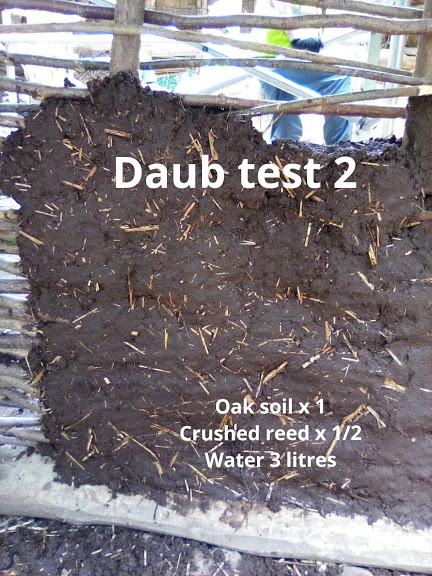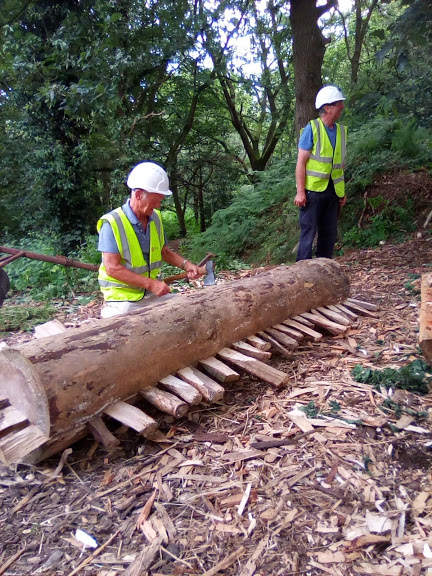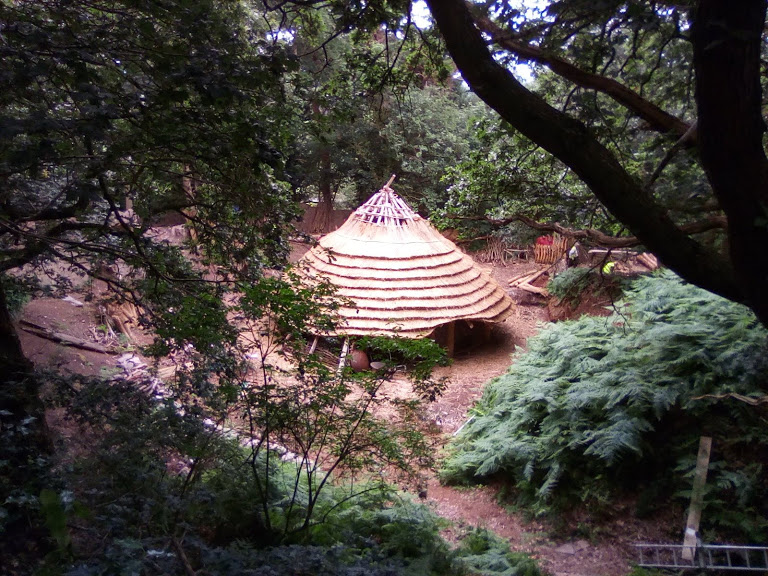8th – 12th July 2019
Phase 3 Construction Week 10
After a three week break, the volunteers reunited this morning on the roundhouse project. The weather is forecast as mostly dry this week, which will be a pleasant change from our somewhat torrential last visit.

The focus remains thatching, there are still many layers to apply, but the bulk of the roof area has already been covered. Each higher ring of thatch shortens by a few bundles and so the task will begin to visually speed up before long.

We are rapidly approaching the final stages of this project and there are several tasks we have to get to grips with in the next few visits. One of these tasks is daubing. The earth based covering that will adhere to the wattle walls and make the building weather tight raises several interesting thoughts on this project. The classic notion of daub centres on clay, mixed with fibre (usually cited as dung) to prevent excessive shrinkage and cracking. This is certainly the case in areas where clay is readily available, but in other areas, daub has always been the local ground material mixed with anything organic to prevent shrinkage. Our project will need to test various types of materials and mixes to discover what works best in this environment. We currently have 12 tests, using a variety of materials and proportions. Time will tell which (if any!) of these will be most suitable for the task.

A volunteer team has also begun the task of thinking about – and building some of the interior furnishings for the building. Once again we face the issue of evidence regarding furniture for this period in the British Isles. We have some evidence from the earlier Neolithic period, and we have a range of evidence from drier climates in the Bronze Age, but we lack the definitive “what was in a Bronze Age roundhouse” evidence from the UK.
My solution to this is based on my own individual approach to reconstructions over the years and is open to debate. Some archaeologists would say that a good reconstruction should only showcase the evidence, or suite of evidence we have from that specific site – that we cannot and should not take evidence from other locations and apply it to a specific site based in a specific cultural and geological setting. Although I understand the detail of this argument, for me, this approach is also flawed, and can only ever present the visiting public with a tiny and unrepresentative sample of what life may have looked like in the past. Differences in preservation would result in some reconstructions having nothing in them, while others (in more desiccated parts of the world) would have an abundance of artefacts and furniture. This would inevitably affect the visitor experience and fundamentally their assessment of specific cultures. A lack of internal artefacts would be seen as a lack of sophisticated culture – rather than a lack of evidence.
My approach has always been one of drawing together technology and artefact evidence and combining it with local material evidence to present a fuller picture of how life could have looked in the past. In this way we push the comprehension of visitors into unexpected places and avenues while presenting a far more realistic view of human achievement in the past. It must be done carefully of course, and the key is to fully inform any visitor of the evidence and where it is from.

I have heard it time and time again over the years from members of the public, the (understandable) underestimation of the abilities and technological sophistication of our recent Bronze Age ancestors, let alone our more distant Palaeolithic cousins. The general view of many visitors is that our ancestors were unsophisticated humans who just “got by” in a harsh world they couldn’t really handle. The evidence, wherever we find it (and for any period), shows the contrary. The issue we have here, is the marked lack of organic evidence in the majority of our archaeological record. The Bronze Age in drier environments is full of amazing, detailed and beautifully made objects such as chairs, tables, shelves, colourful visual depictions, nets, baskets, containers, utensils. From nearer at home, a few water logged discoveries from earlier dates give us sophisticated carpentry evidence. The challenge for volunteers on this project is to use that evidence, and their technological know how to produce furniture and fittings for the building. It has to be appropriate, and fulfil the need of a working building.

The volunteers have begun work on a storage unit for the house. This is using some of the remaining larger hazel rods from the build as a framework and will support shelves.

The main door thresholds are also being positioned. A simple water level was employed by Edwin to ensure they sit in the right position, and our final piece of good oak was split to produce a matching pair.

The thatch is beginning to race towards the top of the house. Each thatching team has found a comfortable rhythm makes for a deceptively easy progress. The task is still gruelling though, and in this weeks high humidity levels, particularly draining.

Wow, what an incredible week it’s been again. The building progresses and becomes more beautiful each day. The quarry lip gives us a unique perspective on a build like this – our very own drone view. I have never really appreciated the form of these buildings from a higher viewpoint, it really illustrates the size of the roof and the epic nature of thatching it!


Well done All!

